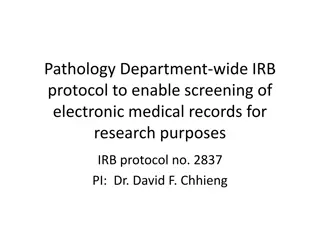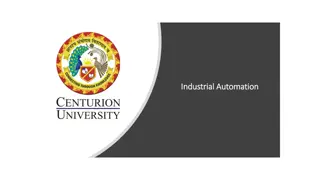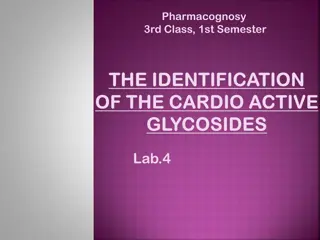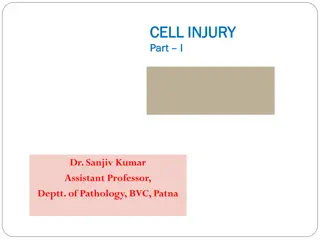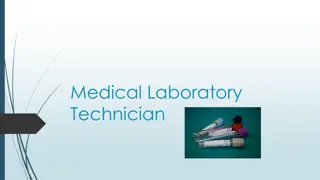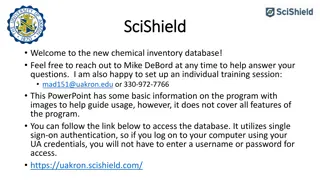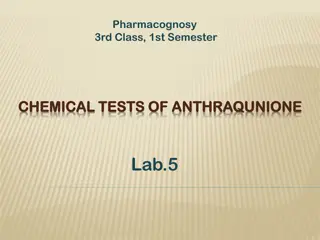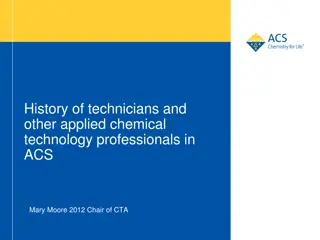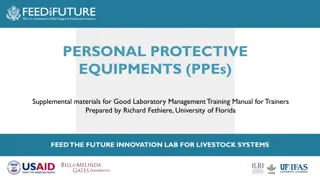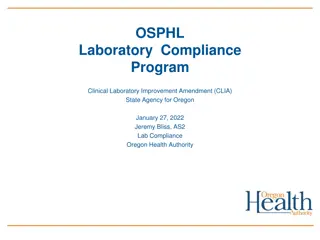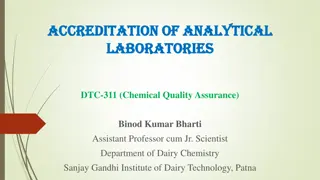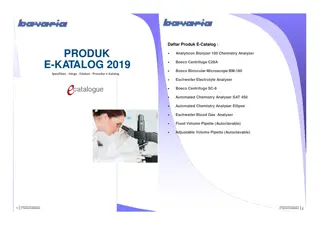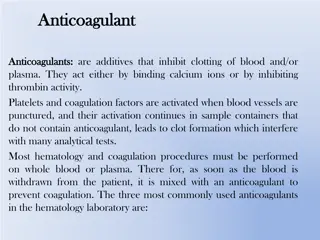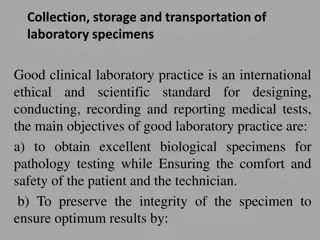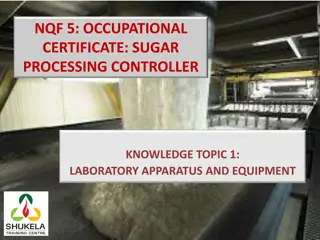Laboratory Automation in Chemical Pathology: A Comprehensive Overview
Laboratory automation in chemical pathology involves the use of control systems to minimize human intervention and improve efficiency in conducting tests. The historical background, types of automation, benefits, total laboratory automation, and important considerations are discussed in detail.
Download Presentation

Please find below an Image/Link to download the presentation.
The content on the website is provided AS IS for your information and personal use only. It may not be sold, licensed, or shared on other websites without obtaining consent from the author. Download presentation by click this link. If you encounter any issues during the download, it is possible that the publisher has removed the file from their server.
E N D
Presentation Transcript
Laboratory Automation Dr. Nayab Zehra PGR Chemical Pathology
What is Automation ? Automation is the use of various control systems for operating equipments and other applications with minimum human intervention. The use of automation in clinical laboratory enables to perform many tests by analytical instruments with minimum use of an analyst.
Historical Background : First automated analyzer was introduced by Technicon in 1957 It was a continuous flow, single channel , sequential batch analyzer capable of providing a single test result on approx. 40 samples per hour. Next major development occurred in 1970 with introduction of Automatic Clinical Analyzer. Most recent milestone in chemistry is the development of an analyzer having combination of chemistry and immunoassay into a single modular analyzer.
Types of Automation : Subtotal automation (modular integrated automation) Total laboratory automation Stand-Alone system Others are Auto-analyzer Closed automation Open automation Discrete analysis Random access analysis
Benefits of Automation : Effectively lowers the cost per test Minimizes the variation in results Coefficient of variance is reduced and reproducibility is increased. Workload is decreased Small amounts of samples and reagents are used decreasing the cost of consumables. Reduce turn around time Increasing the quality of work
Total laboratory automation : Total Laboratory Automation (TLA) is an automation system for the performance of highly repetitive tasks in the Laboratory. Laboratory automation consolidates the control of multiple different analytical instruments to a smaller number of operators, thus reducing the costs in laboratory testing. TLA is the most recent and most exciting development in Chemical Pathology Laboratories. It consist of 3 main parts : Pre analytic phase (sample processing) Analytic phase ( chemical analysis) Post analytic phase (data management)
Important Considerations : Economic and reliable operation Reduce human resource cost Lab space (cost of space renovations) Up-gradation/ menu extension Service back up Availability of on-site biomedical engineer Standardization of specimen tubes
Automated analyzer : Specimen identification Specimen preparation Chemical reaction Data collection Analysis
Pre Analytic Phase : The pre-analytic testing phase occurs first in the laboratory process. This phase may include specimen handling issues that occur even prior to the time the specimen is received in the laboratory. Important errors can occur during the pre- analytic phase with specimen handling and identification.
Steps of Pre-Analysis : It includes Specimen barcode Data entry of patient Transportation of specimen to specified area. Loading of specimen on track Centrifugation Decapping To the analyzer
Steps Automated in the Diagnostic Laboratory Post-Analytical Pre-Analytical prepare order collect sample transport to lab Sample retrieval accession sample store samples centrifuge dispose of waste decap tubes post-sort transmit test results pre-sort/aliquot transport to analyzer technical validation Analytical
Analytic phase : The second phase is the analytic phases. This phase includes what is usually considered the "actual" laboratory testing or the diagnostic procedures, processes, and products that ultimately provide results. It includes Input / output module Tube storage module
Continuous flow analyzer : An automated chemical analyzer in which the samples and reagents are pumped continuously through a system of modules interconnected by tubing. It operates by introducing a sample and reagent(s) into tubing separated by bubbles. Each segment of sample mixture goes through a mixing coil or other tubing where chemical reactions occur. Various modules can be introduced to perform specific chemical reactions. There are significant carry-over problems and wasteful use of continuously flowing reagents, which lead to the demise of these analyzers.
Advantage : Major use for certain test profiles (e.g. liver function, lipid function). Single channel machines may be used for frequently requested independent analysis (e.g. blood glucose, blood total protein). Disadvantages: The machine does not allow test selection; all tests must be performed even if not requested.
Centrifugal Analyzers : Centrifugal Analyzers : Discrete aliquots of specimens and reagents are pipetted into discrete chambers in a rotor. Centrifugal force is used to mix specimen and reagents. The rotary motion is then used to move the cuvettes through the optical path of an optical system
Advantage Rapid test performance, analysing multiple samples. Batch analysis is a major advantage because reactions in all cuvets are read virtually simultaneously. Use small sample (as small as 2 L). Use small reagent volumes (250 L). Disadvantage Only one test type can be performed each time. Each cuvet must be uniformly matched to each other to maintain quality handling of each sample
Discrete Analyzers : Discrete Analyzers : Separate testing cuvettes for each test and specimen. They have the capability of running multiple tests on one specimen at a time or multiple specimens testing at one time. Most popular analyzers and have almost completely replaced continuous-flow and centrifugal analyzers. Separate reaction cuvettes, cells, slides, or wells that are disposed of following chemical analysis are used. This keeps specimen and reaction carryover to a minimum but increases the cost per test due to disposable products. These analyzers are also called random access analyzers
Advantage : Assay by reflectance photometry offers advantages: -The storage requirements for reagents are minimal since no wet reagents are required. -No pipetting steps are needed as the manufacturing company prepares the slides. -No sample dilution is required and 10 or 11 l of sample per test is used. Dis-advantages: Since each sample is in a separate reaction container, uniformity of quality must be maintained in each cuvete so that a particular sample quality is not affected by the cuvete it is placed in.
Post-analytic phase : The post-analytic phase is the final phase of the laboratory process. This phase culminates in the production of a final value, result, or a diagnostic pathology report. The computer is connected with the software of the equipment and report can be generated by giving order.
Four Q Model of Instrument Four Q Model of Instrument Qualification : Qualification : Design Qualification: documentation of required specifications of design and its function. It also documents qualification of vender or supplier. Installation Qualification: documented verification that system is installed according to written and preapproved specifications Operational Qualification: includes verification that system is operating in accordance with preapproved and written specifications under normal and stressed conditions. Performance Qualification: it includes ongoing monitoring of performance, testing for specified application and periodic updates about the analyzer.










